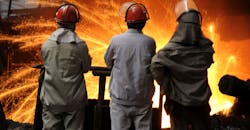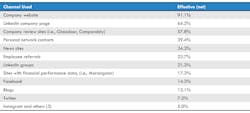Your ‘brand’ is what your customers say about you when you aren’t in the room, according to one common definition. By extension, your reputation as an employer — your employer brand — is what current and past employees say about working for you. If you do not think of your employees as customers you should, because they might be.
Some years ago at an American Marketing Assn. event I attended a representative of Deloitte explained the consulting giant had 1,000 applicants for any single job opening. Of these, 60% who were not hired would one day be in position to engage Deloitte’s services. It was the first time I’d heard of a company treating its own application and hiring process as a future customer opportunity. It was the first time I heard anything about employer branding.
Since then the definition of employer branding has expanded along with our understanding of what a brand can accomplish. A simple, widely recognized version is: “Employer brand describes an employer's reputation as a place to work, and its employee value propositions.”
A number of things you already do will contribute to your employer brand, but these things need to be framed by a branding process, plan, and goals.
Creating your employer brand can be outlined as four steps:
1. Brand training. This means making sure employees have a complete understanding of what your brand stands for, and what that means for their role in the organization. There is an insurance company with a 500-word mission statement. Every employee can quote it verbatim; but more important, each employee can tell you how the statement impacts how he/she perform his/her job. This deep "brand understanding" is the result of brand training.
2. Organizational communication. Talk the talk and walk the walk. Let new employees and old employees see managers and department heads consistently and frequently demonstrating company mission and values, formally and informally.
3. Hiring and recruitment. Hiring starts long before they walk through your door. It begins as recruitment outreach to both passive and active job seekers, because if they don’t know who your company is they will not seek to work there.
4. Employee experience. To the best of your ability, establish a workplace that employees will boast about to family and friends. Make sure compensation (reviews) is fair and competitive with (or better than) the market. Offer education (including upskill opportunities) and options for advancement. Establish community standing by being a good corporate citizen, in your location and on social issues. Provide a work environment reflective of the company culture, differences and experience.
It's important to recognize that many manufacturing organizations already embrace parts of the employer branding process, some without even realizing it, and others proceeding step-by-step. The metalcasting world has some stand-out examples of employer branding in process. Companies like Waupaca Foundry, with staff dedicated to employer branding, and Dotson Iron Castings, with a management focus on employee experience, have a leg up. Other metalcasters have started where they can and are building.
Oil City Iron Works, Corsicana, TX, stages a 90-day hardhat ceremony to establish employees as permanent team-members, updating the color of the headgear assigned to a workpod. It's a simple, quick, and low-cost way to recognize individuals and the team, and it strengthens the workplace culture while giving the employee an experience to share with family and friends.
Buck Company, Quarryville, PA, has its HR department handling social media. A recent Memorial Day post featured a team member who is a reservist, effectively granting recognition to the individual while emphasizing the company's values, and demonstrating pride in employee accomplishments.
Dotson Iron Castings, Mankato, MN, focuses on talent retention and employee experience, starting on day one with a branded shirt. After three months, team members share a meal and their experiences with someone from Dotson's leadership team. The foundry extends its management communication effort with weekly shift meetings and quarterly leadership meetings. During the Covid-19 crisis, Dotson leaders sent video messages to the team — an authentic, face-to-face connection at a time when meeting in-person was not an option.
BCI Solutions, Bremen, IN, (formerly Bremen Castings), Dotson, and Eagle Alloy in Muskegon, MI, are among the many metalcasters taking the Foundry in a Box experience into local schools. Each of these foundries has a long-standing community presence, and their managements know well the value of cultivating a future workforce, emphasizing skills development and individual opportunities in manufacturing.
And, they're right: According to a widely publicized, 2017 Deloitte study, less than 30% of parents would recommend manufacturing as a career to their children. However, among parents with exposure to manufacturing, that number doubled.
ATEK, in New Hampton, IA, donated a high-value technology space to the local high school, complete with a working foundry, aiming to launch a metalcasting apprenticeship program. BCI Solutions offers free annual sports physicals for any student at it on-site healthcare facility.
Each of these efforts creates goodwill in the community, and that bolsters the foundries' brands in those communities while reaffirming the values of each company. This is employer branding.
Foundries today know they need to engage their employees more regularly than just the annual picnic, and that they need to show their best assets to the community and future employees. It starts by being where the audience (employees or potential employees) is, in person and digitally. BCI Solutions hosts an employee-only Facebook group to engage their staff — and by extension, their social circle. ATEK's Facebook presence is focused on employee interaction and posts that may be shared to the larger community. Dotson offers afterhours community tours, and BCI regularly hosts high-school tours. All of these activities may be expanded to build the community and future-employee brand awareness.
Consider which of the above examples you might adapt to your company's processes. Waupaca Foundry’s Director of Marketing Sara Timm spoke on this topic the American Foundry Society’s 2019 Foundry Leadership Conference, and she offered a roadmap for metalcasting leaders and their HR and marketing teams.
Think about who is responsible for the experience of your brand. (Pro-tip: To some degree, everyone is responsible for the experience of a brand.) As it relates to employees, where the brand is amplified, there is cross-functional alignment between marketing and HR. What might that look like?• Is your website career page easy to navigate? Does it showcase the benefits to working there? Does it explain the company culture?
• Map out the job seeker journey and potential touchpoints with the brand as you would a customer journey. Seek out feedback from recent hires on the accuracy of the employee map.
• Create content for and about employees. Newsletters, social media posts, videos, company website pages, etc. Make sure your employee-recognition programs appear where people will look for it. For example, don’t post anniversaries on Twitter. Twitter usage is low. Facebook, which has a much higher usage, is a better bet or perhaps even LinkedIn.
• Put content where employees (and potential employees) can find it. Think about various channels in terms of owning it (website, newsletter, social media), earning it (press coverage) or paying for it (advertising.) In today’s digital first world, remember that the most effective ways for future employees to find you are probably on channels you control.
What metrics should you use? Begin with a trusted source as a benchmark. The Society for Human Resource Management says it costs 6-9 months' salary, on average, to replace a salaried employee. The U.S. Department of Labor says the price of a bad hire is 30% of the employee’s first-year of earnings. How do those numbers compare to your company’s experience?
Start your employer branding effort with "communication." Get your HR and marketing staffs talking together. Put your company messaging on the channels you own. Have your managers talk to staff, regularly. Communicating who you are and what you stand for will create an employer brand that is worth talking about.
Alexandria Trusov is the Global Marketing Manager at Alpha Resources and a B2B marketing consultant to manufacturers and other B2B companies. Contact her at [email protected] or visit www.truinsightsconsulting.com.About the Author
Alexandria Trusov
Global Marketing Director
Alexandria Trusov is the Global Marketing Director at Alpha Resources and a B2B marketing consultant to manufacturers and other B2B companies. Contact her at [email protected] or visit www.truinsightsconsulting.com.

